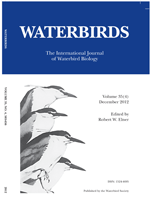The Socotra Cormorant Phalacrocorax nigroogularis is a little studied, regional endemic seabird restricted to the Arabian Gulf region threatened by anthropogenic disturbance. The global population is estimated at 110,000 breeding pairs. The Siniya Island colony, the largest in the United Arab Emirates (∼ 15,500 breeding pairs), was studied during the 2011 breeding season to determine baseline reproductive parameters and the effect of exotic trees on reproductive performance. Mean nesting density was 0.92 nests/m2 and shaded areas had significantly higher density (1.05/m2) compared to unshaded areas (0.75/m2). Mean clutch size was 2.4 eggs/nest and did not differ between shaded and unshaded areas. Mean egg volume was significantly higher in shaded (49.56 cm3) compared to unshaded areas (48.5 cm3). Hatching success was significantly higher in shaded (65.1%) compared to unshaded areas (46.6%). Fledging success was 65.6% and did not differ between shaded and unshaded areas. Chicks crèched under trees soon after leaving their nests and this likely increased fledging success, regardless of whether chicks came from shaded or unshaded areas. Overall reproductive success was 1.7 chicks/nest. Higher egg volumes and hatching success under shaded areas suggest that plantations had a beneficial effect on the cormorants on Siniya Island and could be of conservation value. Further studies are required to determine what habitat features linked with these trees specifically aid in enhancing reproductive performance.
How to translate text using browser tools
1 December 2012
Reproductive Performance of the Socotra Cormorant Phalacrocorax nigrogularis on Siniya Island, United Arab Emirates: Planted Trees Increase Hatching Success
Sabir Bin Muzaffar,
Robert Gubiani,
Sonya Benjamin
ACCESS THE FULL ARTICLE

Waterbirds
Vol. 35 • No. 4
December 2012
Vol. 35 • No. 4
December 2012
breeding success
fledging success
hatching success
Phalacrocorax nigrogularis
reproductive performance
reproductive success
Socotra Cormorant




